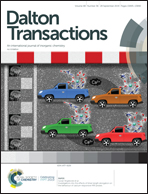Assessment of the intramolecular magnetic interactions in the highly saddled iron(iii) porphyrin π-radical cations: the change from planar to saddle conformations†
Abstract
The intramolecular magnetic interactions in one-electron oxidized iron(III) porphyrin π-radical cations, [Fe(OETPP˙)Cl][SbCl6] (1), [Fe(OMTPP˙)Cl][SbCl6] (2) and [Fe(TPP˙)Cl][SbCl6] (3), have been compared by means of X-ray crystallography, SQUID magnetometry, cyclic voltammetry, UV-Vis spectroelectrochemical analysis, NMR spectroscopy analysis and unrestricted DFT calculations. Unlike a generally recognized antiferromagnetic coupling dxy↑dxz↑dyz↑dz2↑dx2−y2↑P˙+(a2u)↓ (S = 2) state via a weak bonding interaction as in (3), we have disclosed that a strong bonding interaction among iron dx2−y2 and porphyrin a2u orbitals forms in (1) into a highly delocalized Ψπ = [P˙+(a2u) + FeIII(dx2−y2, dz2)] orbital that is able to accommodate two spin-paired electrons to form the Ψπ2dxy1dxz1dyz1, dz21 (S = 2) ground state. Concurrently, the spin polarization effect is exerted on the paired spins in the Ψπ orbital by magnetic induction from the remaining unpaired electrons in the iron d orbitals. The interpretation mentioned above is further verified by the diamagnetic nature of the saddled copper(II) porphyrin π-cation radical, CuII(OETPP˙)(ClO4) (S = 0), where the strong bonding interaction leads to the Ψπ2dxy2dxz2dyz2dz22 (S = 0) ground state but no spin polarization exists. Thus, the magnetic nature of the iron(III) porphyrin π-radical cation is tuneable by saddling the ring planarity.



 Please wait while we load your content...
Please wait while we load your content...